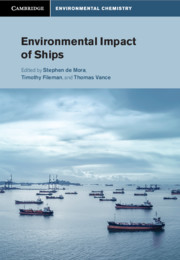Book contents
- Environmental Impact of Ships
- Cambridge Environmental Chemistry Series
- Environmental Impact of Ships
- Copyright page
- Contents
- Contributors
- Preface
- 1 Shipping, Ships and the Environment
- 2 Atmospheric Emissions from Ships
- 3 Oil Pollution from Operations and Shipwrecks
- 4 Waste and Sewage
- 5 Ballast Water
- 6 Biocides from Marine Coatings
- 7 Invasive Species
- 8 Physical Effects of Ships on the Environment
- 9 Ship Noise
- 10 Vessel Strikes and North Atlantic Right Whales
- 11 Nuclear-Powered Vessels
- 12 Environmental Impacts of Shipbreaking
- 13 International Legislative Framework
- 14 Shipping Industry’s Perspective
- 15 Environmental Impacts of Shipping
- Index
- References
6 - Biocides from Marine Coatings
Published online by Cambridge University Press: 22 January 2021
- Environmental Impact of Ships
- Cambridge Environmental Chemistry Series
- Environmental Impact of Ships
- Copyright page
- Contents
- Contributors
- Preface
- 1 Shipping, Ships and the Environment
- 2 Atmospheric Emissions from Ships
- 3 Oil Pollution from Operations and Shipwrecks
- 4 Waste and Sewage
- 5 Ballast Water
- 6 Biocides from Marine Coatings
- 7 Invasive Species
- 8 Physical Effects of Ships on the Environment
- 9 Ship Noise
- 10 Vessel Strikes and North Atlantic Right Whales
- 11 Nuclear-Powered Vessels
- 12 Environmental Impacts of Shipbreaking
- 13 International Legislative Framework
- 14 Shipping Industry’s Perspective
- 15 Environmental Impacts of Shipping
- Index
- References
Summary
Colonization by fouling organisms is a problem that has challenged operators of ships since humans first took to the seas. Reducing or preventing the fouling of a ship’s hull is important to allow the vessel to pass efficiently through the water. For centuries, fouling has been controlled through the application of a coating that discourages fouling organisms. As early as the third century there are reports of the Greeks using tar and wax to coat ships’ hulls, and as early as the sixteenth century there are reports of copper sheathing or mixtures containing arsenic being used as anti-fouling (AF) coatings on wooden ships. Many of these and the AF solutions that followed were based on the presence of a toxin in the paint to deter organisms from colonizing the painted surface. Cuprous oxide has been used as a biocide since the early nineteenth century and continues to be a common component of modern AF products. The twentieth century saw the introduction of contact leaching AF coatings designed to increase the efficacy and active lifetime of the coating. Typically, these paints contained copper and zinc as the biocidal additives and would be released through dissolution of the painted surface or leaching from an insoluble paint matrix. A major advancement in AF technology was the introduction of self-polishing paints where organotin (OT; typically tributyltin (TBT)) biocides that were incorporated into the paint polymer would allow for controlled release of the biocide as the polymer surface was hydrolyzed. Environmental concerns regarding the use of TBT as an AF biocide saw a ban on its use and the introduction of new, primarily organic biocides, often used alongside other biocides such as copper oxide. A common feature of these coatings has been the release of a biocide(s) into the environment. While modern coatings now aim to be biocide free, AF biocides continue to be developed and introduced onto the market. This chapter provides a comprehensive overview of our understanding of the potential harm caused by biocides released from AF paints applied to ships.
- Type
- Chapter
- Information
- Environmental Impact of Ships , pp. 112 - 164Publisher: Cambridge University PressPrint publication year: 2020
References
- 3
- Cited by

